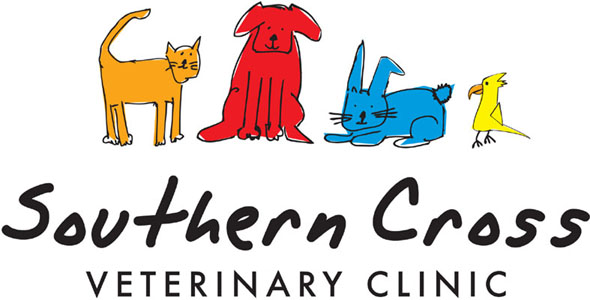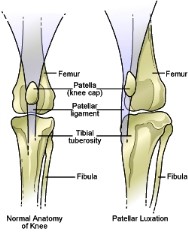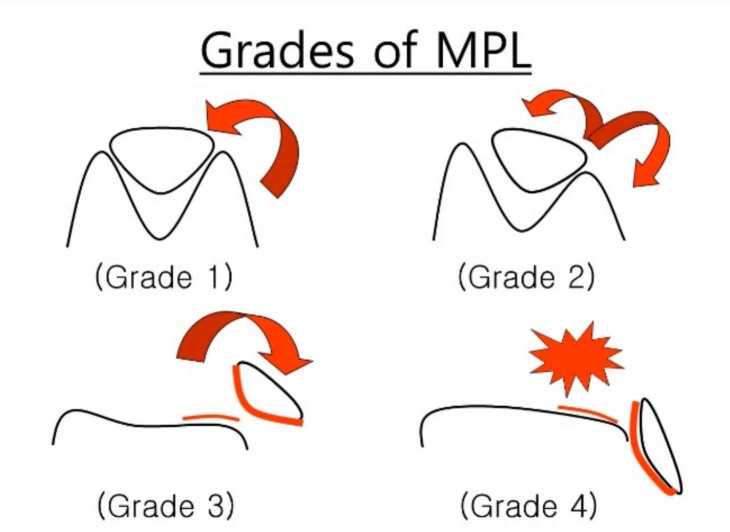

Spotlight on...Patella Luxation
What is patella luxation?
The patella or knee cap is one of the structures of the stifle (knee) joint. This small bone sits within a groove (trochlear groove) on the front of the femur (thigh bone). It is attached to the quadriceps muscles by a tendon and to the tibia (shin bone) by a ligament (patellar ligament). The patella forms a fulcrum for the lever like action of the quadriceps muscle group. As these muscles contract they pull on the patella causing the knee joint to be extended. Patellar luxation occurs when the patella is pulled out of the groove on the front often femur. The dislocation of this small bone prevents extension of the knee joint. The patella can only return to its anatomical position when the quadriceps muscle group lengthens. This is why dogs with this condition may be seen holding up their affected leg.
Patella luxation is one of the most commonly diagnosed orthopaedic conditions in dogs. Luxation almost always occurs towards the inside (medial patellar luxation) of the leg, although in roughly 10% of cases luxation occurs towards the outside (lateral patellar luxation). The anatomical cause of the patella's luxation may be that the groove on the front of the femur is too shallow, a weak or stretched patellar ligament, or a too medial attachment of the patella ligament on the tibia. The cause may also be due to poor conformation of the hip joint or malformation of the femur or tibia.
Evidence indicated these anatomical problems have genetic causes, though patella luxation occurs as a result of trauma in a small number of incidences. It is therefore recommended not to breed with an affected dog. Breeds especially predisposed to the condition include: Miniature and Toy Poodles, Maltese, Jack Russell Terriers, Yorkshire Terriers, Pomeranians, Pekingese, Chihuahuas, Cavalier King Charles Spaniels, Papillons; Boston Terriers, Labrador Retrievers, Golden Retrievers, Shar Pei, Flat-Coated Retrievers, Akitas, Great Pyrenees, Malamutes, Boxers, Huskies and St. Bernards. In almost half of all cases both knees will be affected.
What are the signs and symptoms of patella luxation?
The signs and symptoms of patella luxation vary with the severity and persistence of the condition. Look out for the following:
·An intermittent skipping gait (holding a hind limb up momentarily)
·Shaking or extending of the hind limb prior to regaining its use
·Sudden loss of support of a hind limb
·A popping sound when your dog moves or shifts
·An abnormal sitting position with the knee placed outwards
·Bow-leggedness in puppies
·Knocked-knee appearance in large breeds
These signs and symptoms tend to be intermittent, but became more frequent and persistent as the disease progresses. In the beginning pain may be limited to the moment when the patella dislocate, but as the condition becomes chronic it may lead to further degenerative changes such as osteoarthritis and the pain associated with the condition may therefore increase.
What treatments are available?
As with the signs and symptoms, so treatment will depend on the severity and persistence of the condition. Veterinarians assign grades based on the severity of the disease, with grades 4 indicating the highest level of severity. In such cases the knee cap remains dislocated and it is not possible to return it to the groove on the front of the femur. In contrast, in the case of a grade 1 luxation the patella will easily and quickly slip back into its normal position. Decisions regarding treatment are best made on a case by case basis in the light of a dog's age and overall health, but grade 1-2 may be treated non-surgically whilst a diagnosis of a grade 3 or 4 luxation requires surgical treatment. Your veterinarian will reach her diagnosis through a hands on evaluation of the joint and x-rays and other diagnostic tests. Depending on her conclusions you may be referred to a specialist orthopaedic surgeon.
Non-surgical cases (Grade 1-2)
Where a non-surgical approach to treatment is indicated by your veterinarian's diagnosis treatment will probably include:
·Exercise restriction
·Body weight management
·Physical rehabilitation/Physiotherapy
·Hydrotherapy
·Nutritional supplements
·Medication
If your dog has a patella luxation that needs non-surgical treatment speak to Dr Alma Kerr at Southern Cross Veterinary Clinic to set up a physical rehabilitation programme for your dog.
Surgical cases (Grade 3-4)
Surgical treatment is indicated where a grade 3 or 4 luxaton is diagnosed, and may be required in some grade 2 cases. Surgery aims to correct the anatomical structures promoting the dislocation of the knee cap and the movement of the patella itself. In 90% of cases surgery successfully overcoming the lameness and dysfunction caused by this disease.
The precise nature of the surgical treatment employed will depend on what is causing the patella to luxate. The surgical options include:
·Ridgestop surgery - this method uses a surgical implant attached by 2 or 3 screws to make sure that the patella slides up and down within its groove, without slipping to one side or the other.
·Tibial tuberosity transposition - a technique which realigns the tendon by moving the tibial tuberosity where it attaches. Bones heal quicker than tendons, and so the bone is cut, moved, and pinned in place. The bone will take 4-8 weeks to heal.
·Recession sulcoplasty - the surgeon removes a wedge of cartilage and bone to deepen the groove in which the patella is located.
·Femoral varus osteotomy - this technique straightens the femur where it's abnormal formation is causing the patella to luxate.
·Soft tissue reconstruction - in most cases there will be a need for the surgeon to loosen tight tissues or tighten loose tissues as part of the surgical correction of the anatomical structures.
In the first 8-10 weeks following surgery physical rehabilitation will help your pet's speed and quality of recovery. Based on the surgery performed and a post-surgical assessment Dr Alma Kerr at Southern Cross Veterinary Clinic will undertake sessions in the clinic and give you a programme to follow at home to ensure that your dog makes a full and strong recovery. This programme will ensure the right balance between inactivity and activity, and will promote the right kinds of activity to promote healing, minimise post-surgical complications, and help return your pet to normal function.
How will treatment help this condition?
Most dogs with grade 1 patella luxation can live a normal and happy life without surgery, especially where their owners adhere to recommendations concerning exercise and body weight management, and follow a physical rehabilitation programme whilst providing appropriate nutritional supplementation. However, it is important to note that conservative approaches will not change the underlying anatomical causes of the condition.
In the case of surgical treatment the aim of returning the dog to normal function is achieved in the vast majority of cases, especially where it is accompanied with an appropriately designed and implemented physical rehabilitation programme in the 8-10 weeks post-surgery. In such cases there's no reason why your pet shouldn't go on to live a normal life. However, it is important to note that the prognosis may be less favourable in large dogs, especially where other anatomical abnormalities are present.
back to Pet Info
back to Home
What is patella luxation?
The patella or knee cap is one of the structures of the stifle (knee) joint. This small bone sits within a groove (trochlear groove) on the front of the femur (thigh bone). It is attached to the quadriceps muscles by a tendon and to the tibia (shin bone) by a ligament (patellar ligament). The patella forms a fulcrum for the lever like action of the quadriceps muscle group. As these muscles contract they pull on the patella causing the knee joint to be extended. Patellar luxation occurs when the patella is pulled out of the groove on the front often femur. The dislocation of this small bone prevents extension of the knee joint. The patella can only return to its anatomical position when the quadriceps muscle group lengthens. This is why dogs with this condition may be seen holding up their affected leg.
Patella luxation is one of the most commonly diagnosed orthopaedic conditions in dogs. Luxation almost always occurs towards the inside (medial patellar luxation) of the leg, although in roughly 10% of cases luxation occurs towards the outside (lateral patellar luxation). The anatomical cause of the patella's luxation may be that the groove on the front of the femur is too shallow, a weak or stretched patellar ligament, or a too medial attachment of the patella ligament on the tibia. The cause may also be due to poor conformation of the hip joint or malformation of the femur or tibia.
Evidence indicated these anatomical problems have genetic causes, though patella luxation occurs as a result of trauma in a small number of incidences. It is therefore recommended not to breed with an affected dog. Breeds especially predisposed to the condition include: Miniature and Toy Poodles, Maltese, Jack Russell Terriers, Yorkshire Terriers, Pomeranians, Pekingese, Chihuahuas, Cavalier King Charles Spaniels, Papillons; Boston Terriers, Labrador Retrievers, Golden Retrievers, Shar Pei, Flat-Coated Retrievers, Akitas, Great Pyrenees, Malamutes, Boxers, Huskies and St. Bernards. In almost half of all cases both knees will be affected.
What are the signs and symptoms of patella luxation?
The signs and symptoms of patella luxation vary with the severity and persistence of the condition. Look out for the following:
·An intermittent skipping gait (holding a hind limb up momentarily)
·Shaking or extending of the hind limb prior to regaining its use
·Sudden loss of support of a hind limb
·A popping sound when your dog moves or shifts
·An abnormal sitting position with the knee placed outwards
·Bow-leggedness in puppies
·Knocked-knee appearance in large breeds
These signs and symptoms tend to be intermittent, but became more frequent and persistent as the disease progresses. In the beginning pain may be limited to the moment when the patella dislocate, but as the condition becomes chronic it may lead to further degenerative changes such as osteoarthritis and the pain associated with the condition may therefore increase.
What treatments are available?
As with the signs and symptoms, so treatment will depend on the severity and persistence of the condition. Veterinarians assign grades based on the severity of the disease, with grades 4 indicating the highest level of severity. In such cases the knee cap remains dislocated and it is not possible to return it to the groove on the front of the femur. In contrast, in the case of a grade 1 luxation the patella will easily and quickly slip back into its normal position. Decisions regarding treatment are best made on a case by case basis in the light of a dog's age and overall health, but grade 1-2 may be treated non-surgically whilst a diagnosis of a grade 3 or 4 luxation requires surgical treatment. Your veterinarian will reach her diagnosis through a hands on evaluation of the joint and x-rays and other diagnostic tests. Depending on her conclusions you may be referred to a specialist orthopaedic surgeon.
Non-surgical cases (Grade 1-2)
Where a non-surgical approach to treatment is indicated by your veterinarian's diagnosis treatment will probably include:
·Exercise restriction
·Body weight management
·Physical rehabilitation/Physiotherapy
·Hydrotherapy
·Nutritional supplements
·Medication
If your dog has a patella luxation that needs non-surgical treatment speak to Dr Alma Kerr at Southern Cross Veterinary Clinic to set up a physical rehabilitation programme for your dog.
Surgical cases (Grade 3-4)
Surgical treatment is indicated where a grade 3 or 4 luxaton is diagnosed, and may be required in some grade 2 cases. Surgery aims to correct the anatomical structures promoting the dislocation of the knee cap and the movement of the patella itself. In 90% of cases surgery successfully overcoming the lameness and dysfunction caused by this disease.
The precise nature of the surgical treatment employed will depend on what is causing the patella to luxate. The surgical options include:
·Ridgestop surgery - this method uses a surgical implant attached by 2 or 3 screws to make sure that the patella slides up and down within its groove, without slipping to one side or the other.
·Tibial tuberosity transposition - a technique which realigns the tendon by moving the tibial tuberosity where it attaches. Bones heal quicker than tendons, and so the bone is cut, moved, and pinned in place. The bone will take 4-8 weeks to heal.
·Recession sulcoplasty - the surgeon removes a wedge of cartilage and bone to deepen the groove in which the patella is located.
·Femoral varus osteotomy - this technique straightens the femur where it's abnormal formation is causing the patella to luxate.
·Soft tissue reconstruction - in most cases there will be a need for the surgeon to loosen tight tissues or tighten loose tissues as part of the surgical correction of the anatomical structures.
In the first 8-10 weeks following surgery physical rehabilitation will help your pet's speed and quality of recovery. Based on the surgery performed and a post-surgical assessment Dr Alma Kerr at Southern Cross Veterinary Clinic will undertake sessions in the clinic and give you a programme to follow at home to ensure that your dog makes a full and strong recovery. This programme will ensure the right balance between inactivity and activity, and will promote the right kinds of activity to promote healing, minimise post-surgical complications, and help return your pet to normal function.
How will treatment help this condition?
Most dogs with grade 1 patella luxation can live a normal and happy life without surgery, especially where their owners adhere to recommendations concerning exercise and body weight management, and follow a physical rehabilitation programme whilst providing appropriate nutritional supplementation. However, it is important to note that conservative approaches will not change the underlying anatomical causes of the condition.
In the case of surgical treatment the aim of returning the dog to normal function is achieved in the vast majority of cases, especially where it is accompanied with an appropriately designed and implemented physical rehabilitation programme in the 8-10 weeks post-surgery. In such cases there's no reason why your pet shouldn't go on to live a normal life. However, it is important to note that the prognosis may be less favourable in large dogs, especially where other anatomical abnormalities are present.
back to Pet Info
back to Home

